Last weekend L and M were still in Washington at WASCA and I had been sitting home for too long, and I wanted to go someplace. I recently saw a writeup in Texas Highways magazine about Denton, a town an hour north of the Metroplex, and it mentioned a huge used book and record store, right on the courthouse square in the old opera house—Recycled Books—which, from the articles description, sounded like a great place for an ex-book dealer and vinyl fan to go rummaging. It also sounded like a slightly cleaner version of Brock’s Books in San Antonio, which is still my yardstick for Incredible (in any sense you want to apply the word) Bookstores.
I called friends in Dallas and begged a bed, packed and filled up the truck, and left directly from Circulith and the Empire. For Friday at the beginning of rush hour, traffic on I-35 was quite good until I got to the hamlet of Troy, at which point the northbound lanes turned into stop-and-go driving for the next twenty miles, all the way to Waco. Which TOTALLY threw off my schedule, but because of where I was going, there was no alternate route to take until I got to Waco. Finally, we got through an interchange construction project on the south side of town, which I think had started all the trouble, and things cleared up.
Once I got north of Waco, I turned off on my favorite alternate route to Dallas, FM 308, also one of PaulaRubia’s favorite drives. 308 is fifty miles of really rural road, and sometimes it’ll be minutes between one car and the next, leaving plenty of elbow and running room which, after the mess on I-35, I wanted some of. The road meanders through Leroy, Birome, Penelope, Malone, Irene, Mertens, and Milford before dropping onto US 77 at Italy. If you never heard of any of those places, you have a lot of company. Except for Italy, which has about two thousand population, not a one of them can muster as many as five hundred people. Their abandoned or nearly-abandoned business districts hint at a more prosperous time before the war, but it’s no more than a hint.
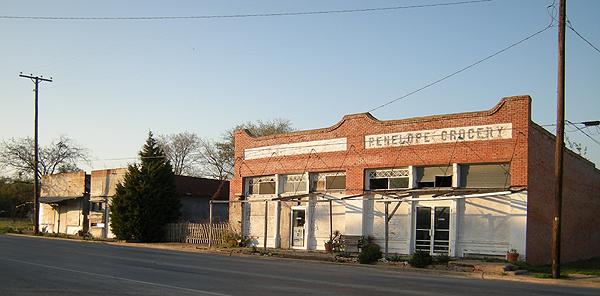
Abandoned storefronts in Penelope
The sun went down before I could do much real picture-taking, but I did capture a little bit. Brighter photos will have to wait for the next road trip, and earlier in the day.
Because I was so late, I ended up finding a restaurant in Dallas along North Central Expressway, a Mediterranean place called Fadi Grill. Their vegetable plates are plenty of food for one person, I found, so if I go there again I’m gonna order the vegetarian plate and let the meats go hang. After that, I found my way to my friends’ house without any trouble (good directions rock!). We visited for a little while, but I was tired and so were they, and we all went to bed—but not before I got an invitation to go with them to a Purim celebration Saturday night at their shul. I knew Purim is regarded as a “party” event in the calendar and figured if they were willing to welcome a stray goy, I ought to go.
Saturday morning I got an early start, and reached Denton before ten. From the look of the square, and the number of conserved and restored storefronts, they have an active Main Street project there, and the courthouse had obviously had some Historical Commission money spent on it, ’cos it was all cleaned up and the corners tucked in, completely pretty. Unfortunately, they lock the place on Saturday so I wasn’t able to admire the interior. I did, however, get to admire and listen to a pickup bluegrass session on the courthouse lawn, which was pretty obviously a regular thing for these guys; everyone knew everyone and there wasn’t any hesitating when someone started a tune—everyone jumped right in.
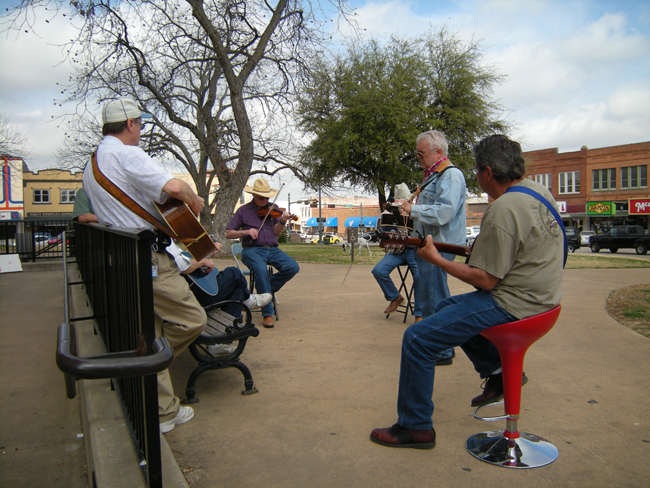
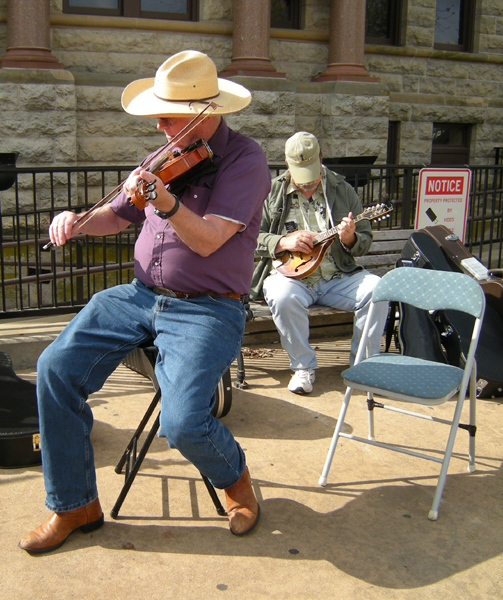
The band
After a little my curiosity came up about the rest of downtown, so I started walking around and admiring buildings, as I’m apt to do. One that particularly caught my attention was just off the square, an Art-Moderne movie house that has been turned into a Little Theater, but with the movie’s façade carefully preserved.
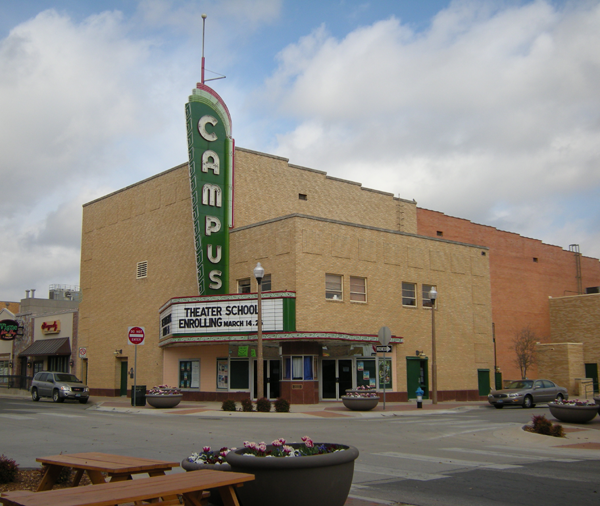
Campus Theater
Eventually I did remember why I had come up to start with, and walked back across the square to Recycled Books which turned out to be what I suspected: a cleaner, less-crowded, better-lit version of Brock’s, and lots of fun to rummage through. I could have spent three or four hundred dollars in there without blinking, but I restrained myself to three or four books and half a dozen albums. The prize of the bunch was a copy of J. Mason Brewer’s The Word on the Brazos, a collection of Negro preacher tales. It was a book I already owned, but the one I had didn’t have a long presentation inscription from Dr. Brewer and this one did, not to mention it cost about half what I paid the first time, so I grabbed it as an upgrade. The best vinyl finds were two albums recorded by Tim Hart and Maddy Prior before they formed Steeleye Span, and an album of union songs by the Almanac Singers, Pete Seeger’s first band, whom I never knew had recorded.
After I pulled myself away from the bookstore I poked through an antique mall down the block for a while, just as entertainment—much of what they had, my family used to have, and most of the rest I wouldn’t want on a bet.
I had a late lunch at a pubbish sort of place, then drove back to Dallas and spent a couple of hours down before dinner and the Purim celebration. Dinner became a good plate of brisket tacos (for me) at a place called the Blue Goose Cantina. That done, we drove across town to Congregation Shearith Israel.
I wasn’t really prepared for all the people showing up in costume; that part of the celebration had eluded me. My friend told me this was usual and customary at Purim, which she referred to as “Jewish Hallowe’en.” I regrouped, decided hey, it’s a party, and went right along.
The service was definitely more festive than anything I grew up with as an Episcopalian. While we don’t have any objection to parties, we generally don’t hold them in church. That was not the case here. As we went in, we each picked up a rattle known as a grager, and each time we heard “Ha-maan” we twirled the gragers, booed and hissed, and generally did our best to drown out his memory by shouting down his name. The chief reader, who was dressed in an approximation of Ahasuerus’s royal robes, did manage to chant the multi-jointed names of Haman’s ten sons who were executed all in one breath, as he was supposed to. My friend explained a little about the diacritic marks in the Hebrew text that act as a kind of musical notation, telling the reader whether the chant goes up or down, when to hurry along and when to hold. And even at that, the reader was going at railway speed to get through all ten chapters, including interruptions, sometime before midnight.
He did wind down about ten, and everyone migrated back out into the lobby, where there were chips-and-queso, vegetable trays, hummus-and-pita, and the obligatory hamantaschen, which is a kind of filled triangular cookie. My friend was disappointed not to find any filled with poppy seeds, which is traditional, but there were some filled with prunes, which is also traditional, and with apricot and strawberry jams.
I left Dallas early Sunday, since I’d promised to go by Comanche on the way home. I got on Highway 377 out of Fort Worth, and trailed through Cresson and Granbury, where there was a festival going on to celebrate General Granbury’s birthday, and the courthouse square was covered up in craft and food booths. (For non-Texans, Hiram Granbury was a Confederate general who got killed along with a raft of other generals during the disastrous invasion of Tennessee.)
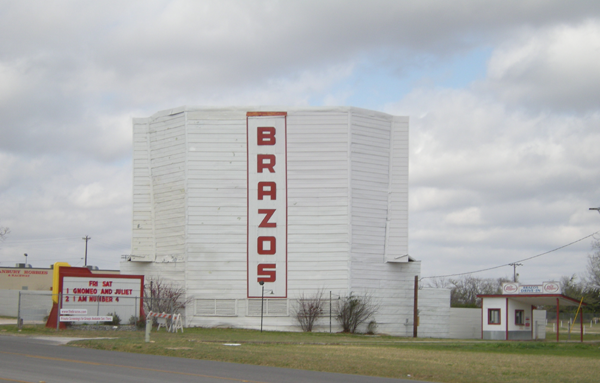
An honest-to-ghods, operating, drive-in movie theater on the outskirts of Granbury. I may have to bring M up one day soon, so she can say she’s actually been to a drive-in.
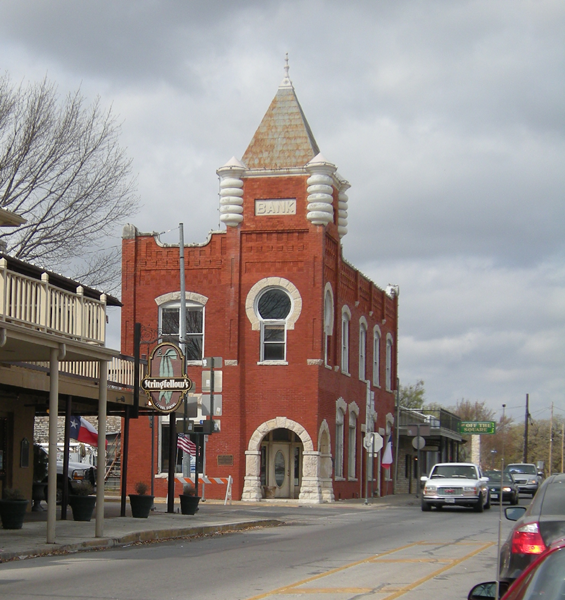
A beautiful Richardson Romanesque bank building on the corner of the square in Granbury, now become a lawyer’s office.
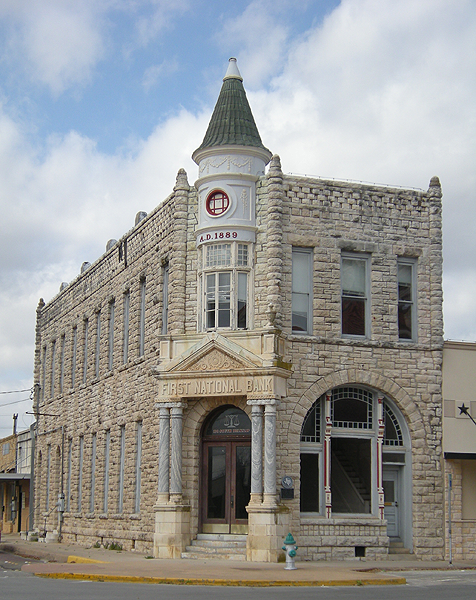
Another Richardson Romanesque bank turned law office, this one in Stephenville
As on FM 308, US 377 has several dying-on-the-vine communities, but with the remains of some fascinating commercial architecture. Between Granbury and Stephenville I found two communities, Tolar and Bluffdale, with extant examples of the 1930s fad for petrified-wood store façades.
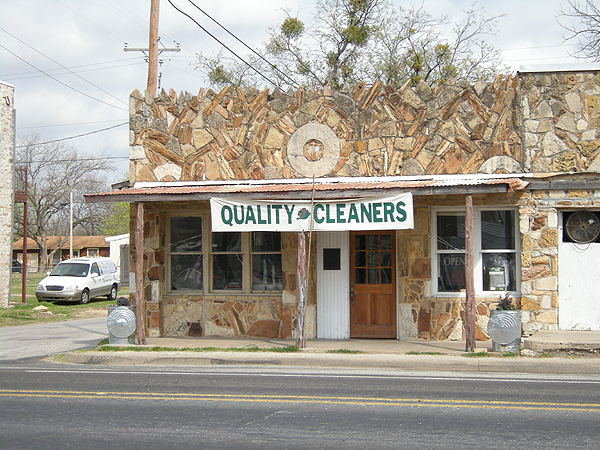
Tolar drugstore-turned-cleaners
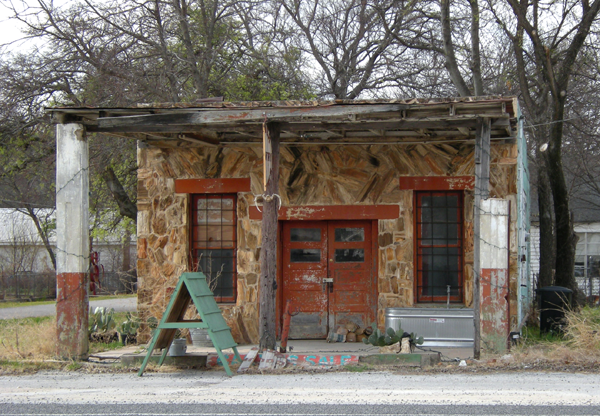
Bluffdale filling station, petrified-wood front
Beyond Stephenville I came to Dublin, which of course required a stop to pick up a couple of cases of Dr Pepper, one for T, another for M and me to split.
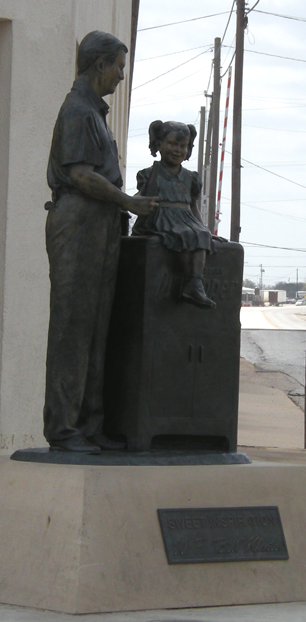
Bronze statue of a former owner of the Dublin plant
And about lunchtime I got to Comanche and Mother’s house, to pick up what turned out to be an ENORMOUS crock that once belonged to my great-grandmother. It holds eight gallons, weighs close to fifty pounds, and is marked with the logo of Love Field Potteries in Dallas, which operated from the early Twenties until a little after the war. Mother said she remembered Mackey making many batches of pickles in that crock; one day I’m going to buy a whole brisket and make some serious pastrami. The immediate question in my mind is where to put it when it isn’t in use. At the moment it’s sitting in M’s bathtub for lack of a better space and because M always uses our shower to bathe anyhow. I also got the dilapidated frame of a Western Maryland railroad lantern, badly electrified by my father, but which I think can mostly be rehabilitated.
Once the crock was loaded into the truck, I sat down to work on Mother’s computer, which needed a lot of housekeeping done to it. I junked a lot of random temp and installation files, defragged the drive, and it ran a good deal better by the time I finished. It’s still a dog of an eMachine, though, for which there’s no help short of replacing it, and I recommended a trip to Discount Electronics after a lease-return Dell desktop, which would run rings around what she has now.
I wound up around five, which would just about let me get home by sunset, and took a few minutes to drive around Comanche taking more pictures of buildings.
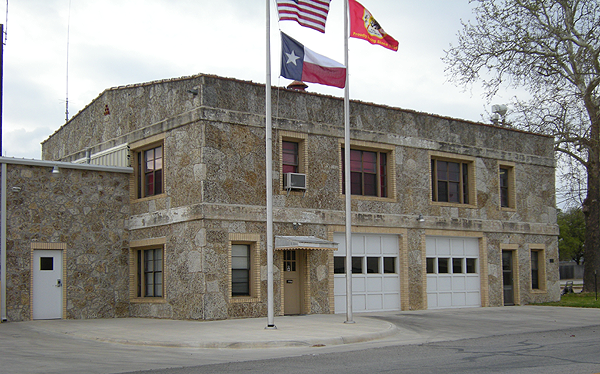
The fire station, built by the WPA in 1939
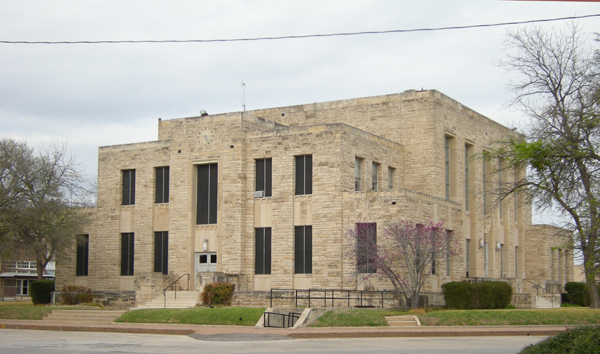
The courthouse, built by the WPA in 1937
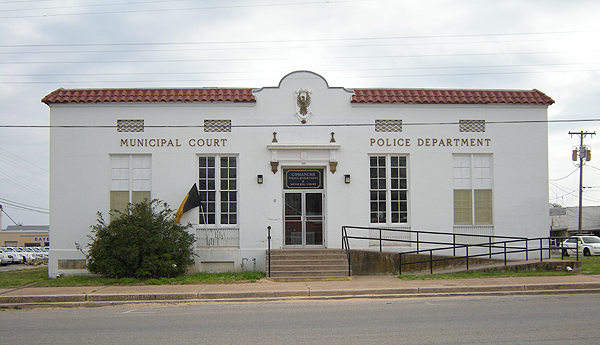
The former post office, built in the middle 1920s, and with Treasury Secretary Andrew Mellon’s name on the cornerstone
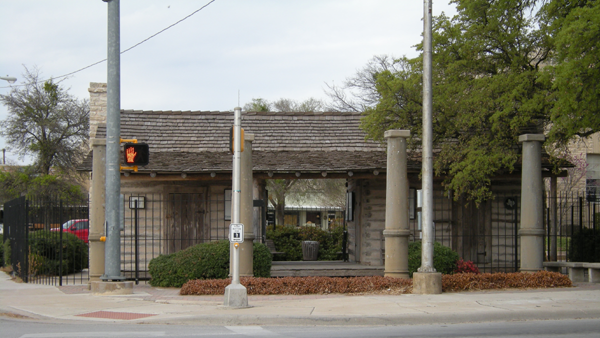
And then there is Cora, the first courthouse for the county, one of the few extant log courthouses in Texas, and certainly the oldest still standing. Very little, if any, of the wood now in it is original to the structure, but the building’s provenance is unquestioned and its history accepted. Restored in the 1990s, it sits on the corner of the current courthouse square next to 377. The sandstone columns in front are almost all that remains of an intermediate courthouse, built in 1890 and demolished in 1936.
By this point it was late enough I wasn’t going to get home in the daylight any more, so I hurried on through Goldthwaite, Lometa, Lampasas, Briggs, and Seward Junction just in time to hit the usual mess of Austin traffic that starts at Leander.

3 Responses to What really went on in Denton